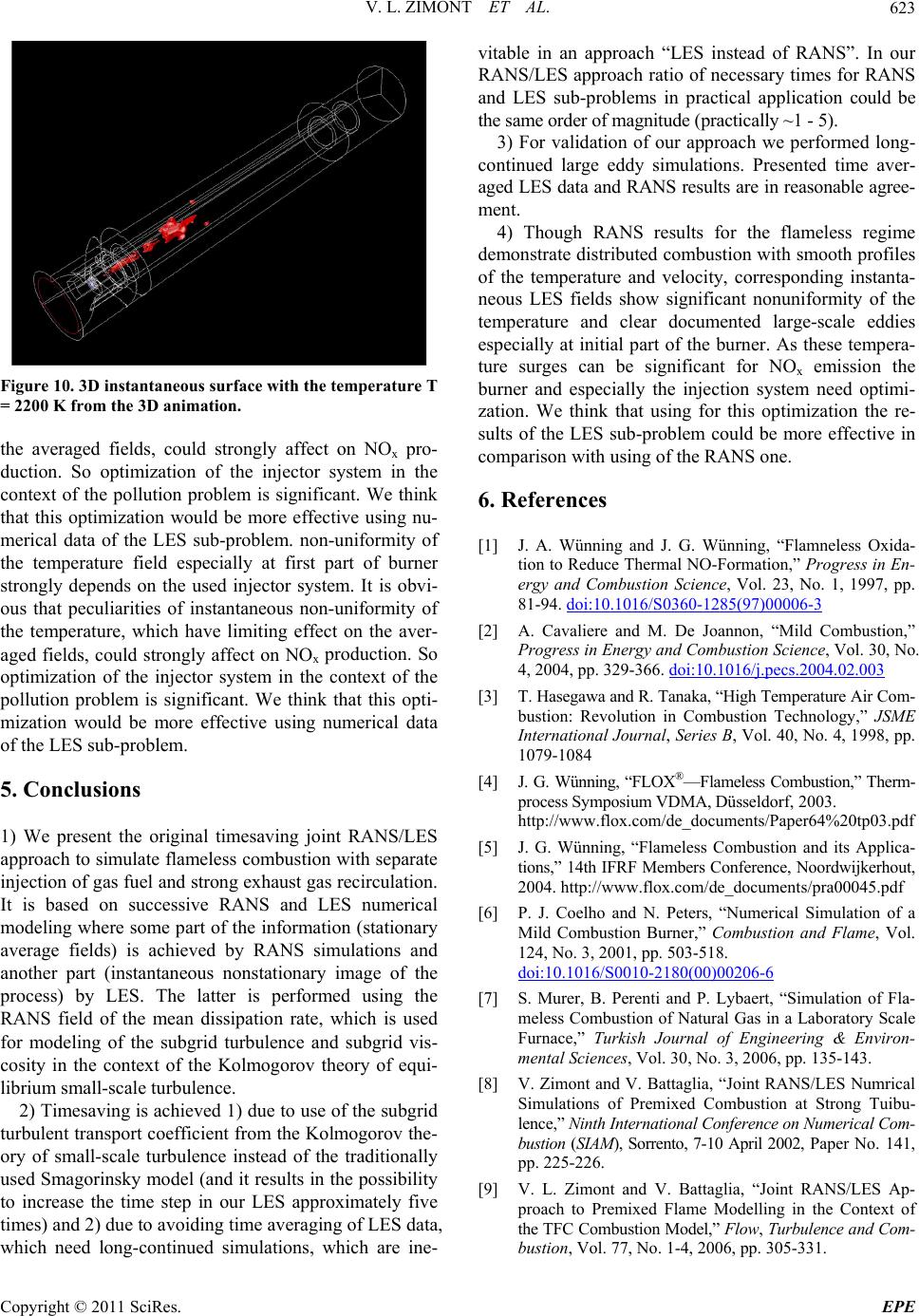
V. L. ZIMONT ET AL.
Copyright © 2011 SciRes. EPE
623
Figure 10. 3D instantaneous surface with the temperature T
= 2200 K from the 3D animation.
the averaged fields, could strongly affect on NOx pro-
duction. So optimization of the injector system in the
context of the pollution problem is significant. We think
that this optimization would be more effective using nu-
merical data of the LES sub-problem. non-uniformity of
the temperature field especially at first part of burner
strongly depends on the used injector system. It is obvi-
ous that peculiarities of instantaneous non-uniformity of
the temperature, which have limiting effect on the aver-
aged fields, could strongly affect on NOx production. So
optimization of the injector system in the context of the
pollution problem is significant. We think that this opti-
mization would be more effective using numerical data
of the LES sub-problem.
5. Conclusions
1) We present the original timesaving joint RANS/LES
approach to simulate flameless combustion with separate
injection of gas fuel and strong exhaust gas recirculation.
It is based on successive RANS and LES numerical
modeling where some part of the information (stationary
average fields) is achieved by RANS simulations and
another part (instantaneous nonstationary image of the
process) by LES. The latter is performed using the
RANS field of the mean dissipation rate, which is used
for modeling of the subgrid turbulence and subgrid vis-
cosity in the context of the Kolmogorov theory of equi-
librium small-scale turbulen ce.
2) Timesaving is achieved 1) due to use of the subgrid
turbulent transport coefficient from the Kolmogorov the-
ory of small-scale turbulence instead of the traditionally
used Smagorinsky model (and it results in the possibility
to increase the time step in our LES approximately five
times) and 2) due to avoiding time averaging of LES data,
which need long-continued simulations, which are ine-
vitable in an approach “LES instead of RANS”. In our
RANS/LES approach ratio of necessary times for RANS
and LES sub-problems in practical application could be
the same order of magnit ude (practically ~1 - 5).
3) For validation of our approach we performed long-
continued large eddy simulations. Presented time aver-
aged LES data and RANS results are in reasonable agree-
ment.
4) Though RANS results for the flameless regime
demonstrate distributed combustion with smooth profiles
of the temperature and velocity, corresponding instanta-
neous LES fields show significant nonuniformity of the
temperature and clear documented large-scale eddies
especially at initial part of the burner. As these tempera-
ture surges can be significant for NOx emission the
burner and especially the injection system need optimi-
zation. We think that using for this optimization the re-
sults of the LES sub-problem could be more effective in
comparison with using of the RANS one.
6. References
[1] J. A. Wünning and J. G. Wünning, “Flamneless Oxida-
tion to Reduce Thermal NO-Formation,” Progress in En-
ergy and Combustion Science, Vol. 23, No. 1, 1997, pp.
81-94. doi:10.1016/S0360-1285(97)00006-3
[2] A. Cavaliere and M. De Joannon, “Mild Combustion,”
Progress in Energy and Combustion Science, Vol. 30, No.
4, 2004, pp. 329-366. doi:10.1016/j.pecs.2004.02.003
[3] T. Hasegawa and R. Tanaka, “High Temperature Air Co m-
bustion: Revolution in Combustion Technology,” JSME
International Journal, Series B, Vol. 40, No. 4, 1998, pp.
1079-1084
[4] J. G. Wünning, “FLOX®—Flameless Combustion,” Therm-
pr ocess Symposium VDMA, Düsseldorf, 2003.
http://www.flox.com/de_documents/Paper64%20tp03.pdf
[5] J. G. Wünning, “Flameless Combustion and its Applica-
tions,” 14th IFRF Members Conference, Noordwijkerhout,
2004. http://www.flox.com/de_documents/pra00045.pdf
[6] P. J. Coelho and N. Peters, “Numerical Simulation of a
Mild Combustion Burner,” Combustion and Flame, Vol.
124, No. 3, 2001, pp. 503-518.
doi:10.1016/S0010-2180(00)00206-6
[7] S. Murer, B. Perenti and P. Lybaert, “Simulation of Fla-
meless Combustion of Natural Gas in a Laboratory Scale
Furnace,” Turkish Journal of Engineering & Environ-
mental Sciences, Vol. 30, No. 3, 2006, pp. 135-143.
[8] V. Zimont and V. Battaglia, “Joint RANS/LES Numrical
Simulations of Premixed Combustion at Strong Tuibu-
lence,” Ninth International Conference on Numerical Com-
bustion (SIAM), Sorrento, 7-10 April 2002, Pap er No . 14 1,
pp. 225-226.
[9] V. L. Zimont and V. Battaglia, “Joint RANS/LES Ap-
proach to Premixed Flame Modelling in the Context of
the TFC Combustion Model,” Flow, Turbulence and Com-
bustion, Vol. 77, No. 1-4, 2006, pp. 305-331.